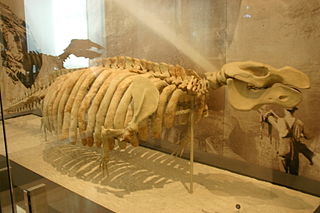Related Research Articles

The Sirenia, commonly referred to as sea cows or sirenians, are an order of fully aquatic, herbivorous mammals that inhabit swamps, rivers, estuaries, marine wetlands, and coastal marine waters. The extant Sirenia comprise two distinct families: Dugongidae and Trichechidae with a total of four species. The Protosirenidae and Prorastomidae families are extinct. Sirenians are classified in the clade Paenungulata, alongside the elephants and the hyraxes, and evolved in the Eocene 50 million years ago (mya). The Dugongidae diverged from the Trichechidae in the late Eocene or early Oligocene.

The Desmostylia are an extinct order of aquatic mammals native to the North Pacific from the early Oligocene (Rupelian) to the late Miocene (Tortonian). Desmostylians are the only known extinct order of marine mammals.

Paenungulata is a clade of "sub-ungulates", which groups three extant mammal orders: Proboscidea, Sirenia, and Hyracoidea (hyraxes). At least two more possible orders are known only as fossils, namely Embrithopoda and Desmostylia.

Tapirus is a genus of tapir which contains the living tapir species. The Malayan tapir is usually included in Tapirus as well, although some authorities have moved it into its own genus, Acrocodia.

Paleoparadoxia is a genus of large, herbivorous aquatic mammals that inhabited the northern Pacific coastal region during the Miocene epoch. It ranged from the waters of Japan, to Alaska in the north, and down to Baja California, Mexico.

Halitherium is an extinct dugongid sea cow that arose in the late Eocene, then became extinct during the early Oligocene. Its fossils are common in European shales. Inside its flippers were finger bones that did not stick out. Halitherium also had the remnants of back legs, which did not show externally. However, it did have a basic femur, joined to a reduced pelvis. Halitherium also had elongated ribs, presumably to increase lung capacity to provide fine control of buoyancy. A 2014 review presented the opinion that the genus is dubious.

Desmostylus is an extinct genus of herbivorous mammal of the family Desmostylidae living from the Chattian stage of the Late Oligocene subepoch through the Late Miocene subepoch and in existence for approximately 21.2 million years.

Kamisetty Ramamohan Rao was an Indian-American electrical engineer. He was a professor of Electrical Engineering at the University of Texas at Arlington. Academically known as K. R. Rao, he is credited with the co-invention of discrete cosine transform (DCT), along with Nasir Ahmed and T. Natarajan due to their landmark publication, Discrete Cosine Transform.

Sirenia is the order of placental mammals which comprises modern "sea cows" and their extinct relatives. They are the only extant herbivorous marine mammals and the only group of herbivorous mammals to have become completely aquatic. Sirenians are thought to have a 50-million-year-old fossil record. They attained modest diversity during the Oligocene and Miocene, but have since declined as a result of climatic cooling, oceanographic changes, and human interference. Two genera and four species are extant: Trichechus, which includes the three species of manatee that live along the Atlantic coasts and in rivers and coastlines of the Americas and western Africa, and Dugong, which is found in the Indian and Pacific oceans.
Behemotops is an extinct genus of herbivorous marine mammal. It lived from the Early Oligocene (Rupelian) through the Late Oligocene, existing for approximately 10.9 million years. It is the most primitive known desmostylian, believed to be close to the ancestry of all other desmostylians.

Metaxytherium is an extinct genus of dugong that lived from the Oligocene until the end of the Pliocene. Fossil remains have been found in Africa, Europe, North America and South America. Generally marine seagrass specialists, they inhabited the warm and shallow waters of the Paratethys, Mediterranean, Caribbean Sea and Pacific coastline. American species of Metaxytherium are considered to be ancestral to the North Pacific family Hydrodamalinae, which includes the giant Steller's sea cow.
Protosiren is an extinct early genus of the order Sirenia. Protosiren existed throughout the Lutetian to Priabonian stages of the Middle Eocene. Fossils have been found in the far-flung locations like the United States, Africa (Egypt), Europe and Asia.

Desmostylidae is an extinct family of herbivorous marine mammals belonging to the order of Desmostylia. They lived in the coastal waters of the northern Pacific Ocean from the Early Oligocene (Rupelian) through the Late Miocene (Tortonian) existing for approximately 26.7 million years.

Paleontology in Florida refers to paleontological research occurring within or conducted by people from the U.S. state of Florida. Florida has a very rich fossil record spanning from the Eocene to recent times. Florida fossils are often very well preserved.

Altungulata or Pantomesaxonia is an invalid clade (mirorder) of ungulate mammals comprising the perissodactyls, hyracoids, and tethytheres.
The Chandler Bridge Formation is a geologic formation in South Carolina. It preserves fossils dating back to the Chattian of the Paleogene period, corresponding to the Arikareean in the NALMA classification. The formation overlies the Ashley Formation and is overlain by the Edisto Formation.
The Alachua Formation is a Miocene geologic formation in Florida. The claystones, sandstones and phosphorites of the formation preserve many fossils of mammals, birds, reptiles and fish, among others megalodon.

Dusisiren is an extinct genus of dugong related to the Steller's sea cow that lived in the North Pacific during the Neogene.

Crenatosiren is an extinct genus of dugongid sirenian known from the late Oligocene (Chattian) of Florida, North Carolina, and South Carolina. The type and only known species is Crenatosiren olseni.

Dioplotherium is an extinct genus of mammal known from Neogene deposits in the southeastern United States.
References
- ↑ "Roy Reinhart - Oxford, Ohio". Death-record.com. Archived from the original on 2013-06-24. Retrieved June 22, 2013.
- 1 2 3 4 5 6 "The Shideler Shibboleth, Alumni Bulletin, Department of Geology, Miami University" (PDF). 2006. Retrieved June 22, 2013.
- ↑ "Natural Areas: Miami University: Reinhart reserve" . Retrieved June 22, 2013.
- ↑ "The Reinhart Reserve: A trail of diverse landscapes and habitats". Miami University. Retrieved June 22, 2013.